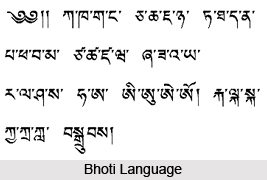 The Bhoti language or Ladakhi language is the principal language in the region of Ladakh in the state of Jammu and Kashmir in India. The Bhoti language is also used as a dialect in Himachal Pradesh, Sikkim, Uttarakhand, Arunachal Pradesh and parts of West Bengal. When the Purig or Burig and Balti dialects are incorporated, then it is called Western Archaic Tibetan by linguists. Bhoti or Ladakhi is intimately linked to Tibetan, and the Ladakhi populace has close cultural resemblance with the Tibetans, particularly Tibetan Buddhism. Although there is ambiguity as to whether they should regarded as distinctive languages but Bhoti and Central Tibetan are not equally comprehensible. Both the languages mutually share a written form which can be traced back to old Tibetan. There are almost 200,000 speakers of Bhoti language in India.
The Bhoti language or Ladakhi language is the principal language in the region of Ladakh in the state of Jammu and Kashmir in India. The Bhoti language is also used as a dialect in Himachal Pradesh, Sikkim, Uttarakhand, Arunachal Pradesh and parts of West Bengal. When the Purig or Burig and Balti dialects are incorporated, then it is called Western Archaic Tibetan by linguists. Bhoti or Ladakhi is intimately linked to Tibetan, and the Ladakhi populace has close cultural resemblance with the Tibetans, particularly Tibetan Buddhism. Although there is ambiguity as to whether they should regarded as distinctive languages but Bhoti and Central Tibetan are not equally comprehensible. Both the languages mutually share a written form which can be traced back to old Tibetan. There are almost 200,000 speakers of Bhoti language in India.
Types of Bhoti Language
Bhoti comprises of several classifications, such as:
* Lehskat or Ladakhi proper- used mostly in Leh, the capital of Ladakh
* Shamskat- used mostly in northwest of Leh
* Stotskat- used mostly in the southeast in the Indus valley; and
* Nubra- used mostly in the north
The assortment of Bhoti or Ladakhi language spoken in Zangskar and Upper Ladakh consists of several features of Bhoti and various other characteristics of western dialects of Central Tibetan. The majority dialects of Bhoti language lack tone, except for Upper Ladakhi and Stotskat which have a similar tone to that of Central Tibetan. The written form of Bhoti is usually more Romanised using modified Wylie transliteration, with a `th` indicating an aspirated dental-`t`, for instance.
Script of Bhoti Language
Bhoti language is generally written in Tibetan script. The occurrence of diglossia, where 2 distinct dialects are utilised by a sole language community, is usual in Bhoti, where it bears close resemblance in pronunciation to written Tibetan than other Tibetan vernaculars. Ladakhis pronounce most of the prefix, suffix and head letters which are silent in Amdo, Kham, Å¡-Tsang or Lhasa Tibetan. This is mostly dominant in west of Leh.
Recent recognition of Bhoti Language
The Ladakh Autonomous Hill Development Council, Leh, passed a resolution for inclusion of Bhoti language in the 8th Schedule of the Constitution without any opposition, on 27 February, 2011. BJP MP Tarun Vijay introduced a private members bill in the Rajya Sabha, seeking amendment to the constitution for inclusion of Bhoti in the eighth schedule, which is considered to be a move that will improve national integration.



















